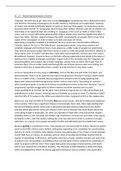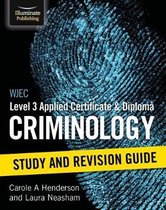AC 1.4 – Media Representations of Crime
Originally, the only way to get news was to read newspapers, meaning they were ultimately trusted
and believed. Nowadays, newspapers are usually owned by individuals and corporations, meaning
an owner may spread a particular opinion or point of view over their papers. As more news can be
accessed online and on TV, newspapers need to keep their readers. Murders and acts of violence are
more likely to be reported than ‘less-exciting’ or ‘engaging’ crimes such as thefts or white-collar
crime, and as a result, 48% of the general public believe violent crime has risen significantly when it
has in fact fallen. This fear created amongst the public consequently encourages them to buy more
copies of the newspapers in order to keep up to date and aware of crimes.
Depending on whether a tabloid or broadsheet, the way crimes are reported will be different.
Tabloids, such as The Sun or The Daily Mirror, sensationalise stories, using more emotive and
simplistic language and therefore have a mass appeal as a wider range of people can understand.
They tend to use larger images with fewer words in order to make the people involved or affected in
these stories clear to readers and therefore make them feel empathetic and thus buy more copies.
Broadsheets, however, choose to focus on the facts, offering explanations and detail in the place of
opinions that a tabloid newspaper would give. Papers such as The Guardian and The Telegraph use
factual headlines and complex, less emotive language, aiming more to inform the reader than to
entertain them. This is further reinforced through the use of fewer pictures and more writing, not
aiming to elicit fear or desperation from a reader in order for them to buy more copies.
Crime is represented in many ways on television, such as The Bill, Law and Order, the News, and
documentaries. These can be split into two types of programmes: fictional or factual, which mostly
focus on violent crimes. Generally, factual programmes present crime as being appalling and
disgraceful, whereas fictional programmes stylise crime to seem more ‘interesting’ or ‘extreme,’
often seeming to glorify it, particularly if those committing the crimes is the main character. Factual
programmes use little exaggeration to inform viewers and allow opinions and accurate
understandings to be formed. On the other hand, fictional programmes are often dramatised and
embellished to entice viewers, showing luxurious lifestyles as a result of crime. Tim Newburn (2007)
said that 10% of TV output in the 1950s was related to crime, compared to 25% in the modern-day.
Allen et al. says that one fifth of all cinema films are crime movies, with up to half having significant
crime content. Films have a significant impact on how people view crime, often representing both
factual and fictional stories. Some seek to document and help viewers understand crime better,
whereas others glamourise crime and violence. Films such as Batman and James Bond portray the
crime being fought as despicable, yet often use vigilantes to fight with crime themselves, despite
depicting them as cool and good role models. Age restrictions can limit how accurately crime can be
portrayed in films, with film studios making the crime less extreme in order to achieve a low age
restriction. As a result, more people will watch the film and ultimately give the studio their money.
Because gaming is considered so new, many people are concerned with its impact. Numerous games
seem to deal with crime in some fashion, with games appearing to be completely for casual playing
and free of crime, or entirely crime-related. A game may glamourise crime or have a moral message.
Grand Theft Auto or Yakuza, for example, portray crime as exciting and thrilling, whether that be
murder or jaywalking. Furthermore, with games that have a looser storyline and give you more time
to explore your surroundings, committing crimes can feel quite visceral compared to requiring to in
order to progress with the story. Many argue that games encourage criminal activity, with Doom
said to have inspired the Columbine shooting. This idea links to Albert Bandura’s Bobo Doll Study,
which investigated the effects of viewing aggressive behaviour had on children, who would then





